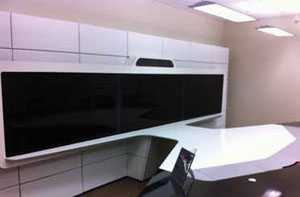Growth Index

Coast to Coast , Integrators Cautiously Chart a Path Toward Recovery
Workplace needs are changing from conferencing access for only a few employees to multipurpose spaces for many.
From the Pacific Northwest down to Texas and up the Northeast corridor, forecasts about the 2012 AV integration recovery outlook are as varied as recipes for mom’s apple pie. Unlike politics, there is no bellwether for predicting this year’s AV growth index. So we went around the country to uncover insights and spending trends for distinct regions.
West South Central
Matthew Zaleski - Vice President, Data Projections - Houston, TX
“Our business has grown since 2004, especially over the last two years in which we have enjoyed 20 percent growth,” Zaleski boasted. “A lot of our growth has come about because Texas has not been affected by government budget or education funding cuts; we haven’t been hit hard compared to California, for example. We have some large education clients which have passed bonds, and as a result there’s bond money available for growth in that market.”
DP’s corporate business, such as boardroom projects, also has seen growth as the oil and gas industries continue to do well. “Videoconferencing and streaming have increased for us,” he said, “and we see growth in margins in those segments as well as in digital signage for 2012. We are also striving to expand our on-site services as we currently have employees working on-site for a major oil and gas client based in Texas.”
Zaleski said DP is optimistic about this year but is not predicting growth over 20 percent. “I feel that the education market will include some districts with less funding. That could be an area of concern, but we see opportunities for continuing corporate growth. With our Polycom OTX , a high-end telepresence system, we see margin opportunities for the larger Fortune 500 companies as they adopt this technology.”
A daily selection of the top stories for AV integrators, resellers and consultants. Sign up below.
DP has been fortunate, he said, in that oil and gas is such a big part of the regional landscape. “To me, Houston and Dallas are among the best cities for business, including tech companies, in 2012. The Houston housing market is up slightly; we haven’t experienced the huge fluctuations in prices in the home real estate market but rather fairly steady growth. Everything has a trickledown effect and with no housing bust, that trickles down to business and community growth.”
NORTHEAST
Thomas Berry, Jr. - CEO , Verrex Corporation – Mountainside, NJ
The economic challenges in North America will continue to push corporations to reduce expenses, requiring workplace technologies that increase efficiencies and reduce costs, Berry said. “We see strong corporate spending through 2012 committed to conferencing because of these initiatives. The Northeast has experienced mild growth over the past three years, driven not as much by new build-outs but more by technology refreshes such as the move from analog to digital.”
Verrex sees traditional workplace needs changing from silo offices and conferencing access for only a few employees to multipurpose spaces, desktop conferencing, and mobile conferencing for many. “Significant technology and IT infrastructure investments are being made to accommodate this push toward broader collaboration and mobility,” he said.
With manufacturers selling technology direct to the end-user in the Northeast market and elsewhere, profit through design, integration, and managed services is the viable alternative, Berry said. “Integrators also need to better understand their worth as professional service providers and raise prices to reflect. With the continued push of networked AV, skill sets and expertise are advancing yet many integrators continue to drop prices and lower bids to compete. These low bidders do not accurately reflect the professional expertise for which our industry should be recognized.”
SOUTHWEST
Jeff Emmons – President, Immedia Audio Visual Solutions - Scottsdale, AZ
“The AV business in the Southwest seems to be holding steady. The residential downturn has dramatically affected the market. However, we are beginning to see some new construction,” Emmons said. “Commercial tenant improvement seems to be gaining momentum.”
The year 2009 was the worst since he founded the company in 2004. “However,” he said, “during 2010 and 2011 we saw significant growth in our business. We anticipate 2012 to be stronger than 2011 with moderate growth in demand of integrated AV solutions.”
Both healthcare and higher education are growing substantially in the Southwest, Emmons said. “The private sector has some growth but the projects are smaller in size. We started a residential division at the end of 2010, and that business is going well. We anticipate significant growth in that vertical during the next 36 months. We are finding that videoconferencing, video walls, and digital signage are all providing us with increased margins.”
SOUTHEAST
Richard L. Arthur - President, Ambassador Enterprises - Montvale, VA
The year 2010 was very slow, Arthur said. “Our FYI of October 31, 2010 revenue was one of the lowest in company history. By FYI Oct 31, 2011, we were back to a normal revenue stream, and 2012 is looking really good. Our focus has been on negotiated sales and design-build projects. Healthcare and government sales have been our strongest areas of revenue, and I think that these, along with higher education, will be the areas that will produce the greatest revenue and profitable projects for 2012.”
Any negotiated projects will be the best for increasing margins, he said. “Those three I believe will be the most plentiful. We are a full systems integrator, so when we get involved we can usually provide all customer needs for lowvoltage systems, and most customers like being able to deal with just one firm for those needs.”
UPPER MIDWEST
Jeff Stoebner - CEO , AVI Systems – Minneapolis, MN
“It’s realistic that we’ll see some level of organic revenue growth in 2012—2009 saw revenue decline, 2010 stabilized, and 2011 grew,” Stoebner observed. “The private sector has been level, education has decreased, and healthcare has increased.”
The smartest way for AV integrators to grow margins in 2012 is by providing support services, he said. “I don’t believe there has been a recovery per se, but rather a change, and that change is affecting companies in two very different ways. Some are doing unusually well, growing at a rate of 25 percent plus, and others are still struggling and shrinking. My sense is that there is little or nothing in between. I’m ecstatic that we’re in the former category, but I wouldn’t be able to say that everyone will see this awesome growth.”
PACIFIC NORTHWEST
Steve Olszewski - Vice President, Dimensional Communications - Mount Vernon, WA
“The only predictable thing about 2012 is its unpredictability.”
That recent Wall Street Journal quote sums it up quite succinctly, Olszewski said. “What this seems to mean in our region is a continuation of the chaotic business landscape of the last few years, perhaps with some glimmer of stable growth in the next 12 months.”
While government work, local, regional, and national, has helped keep the integration business afloat, he sees this area of opportunity waning as stimulus monies and allied projects run their course in conjunction with continued public sector funding problems.

Data Projections offers the Polycom OTX, a high-end telepresence system presents margin opportunities for the larger Fortune 500 companies.
“The hope is for a private sector rebound, and certainly the cash hoarding and protectionist mindset of private companies can’t last forever,” Olszewski said. “At some point private companies, across all sizes and sectors, must open their wallets to perform long-deferred and needed projects. The question is when and how this will happen, not if. This will all appear in a chaotic manner based on the economy and a calculated risk/ reward metric; some businesses will move more quickly than others into a rebound environment.”
Dimensional noted pent up demand in IT -based corporate telecommunications upgrades including business, telephone, and videoconferencing systems, as well as associated AV systems for conference rooms and meeting spaces.
“As the landscape of standards- based videoconferencing churns, so will price-performance ratios,” Olszewski said. “From Skype-enabled desktop applications, thanks to Microsoft’s acquisition of the technology, to full-blown telepresence suites, further downward pricing pressure, consumer awareness, and growing human acceptance of videoconferencing as a tool will help mainstream this segment. Those who understand the convergence of cheap and open technical architectures with closed and proprietary approaches will be best poised to navigate this sea change in video communications and collaboration.”
Cloud environments also provide technology potential, he said. “Breaking down barriers between devices, storage, and access has always beat building up silos and fences; this is a key tenant driving converged systems along with greater bandwidths. This means integrators need to understand mobility devices and connectivity in how people want to use their systems and manage content. Leadership through the fog of convergence is still a great asset for integrators, as are deep IT chops. The same can be said for most emerging network-centric technologies such as AVB, wireless data, RF over UT P, HDBaseT, and the ubiquitous IP ecosystem including SI P transport.
Ultimately, no matter where you work from local to global market, the recovery outlook will depend on political stability, Olszewski said. “As James Carville once said, ‘It’s the economy, stupid’.”
Karen Mitchell is a freelance writer based in Boulder, CO.
